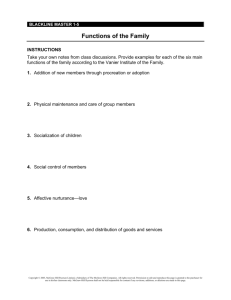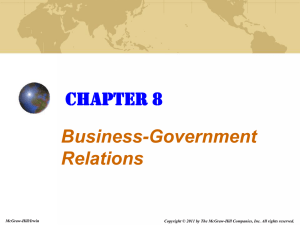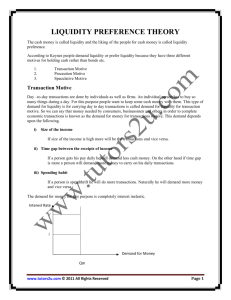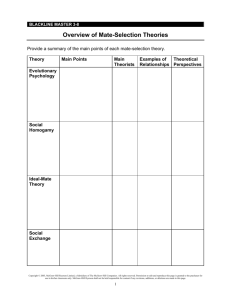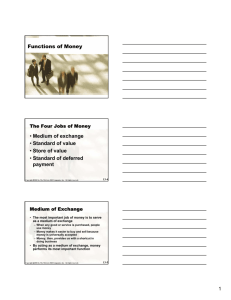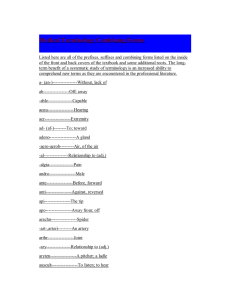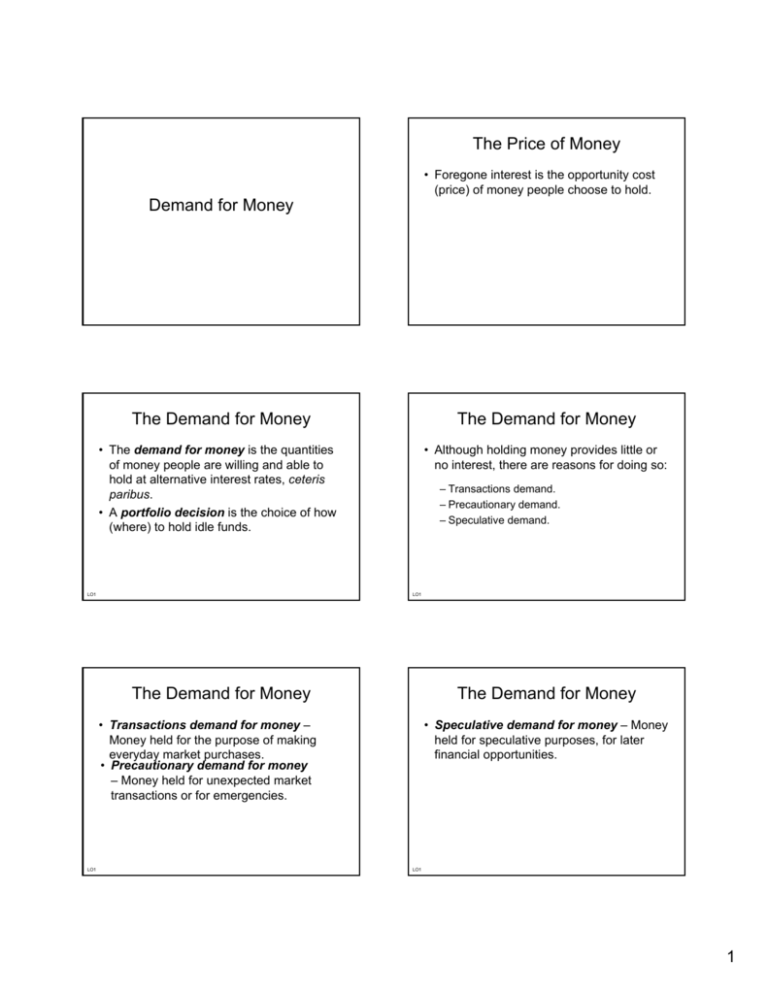
The Price of Money
• Foregone interest is the opportunity cost
(price) of money people choose to hold.
Demand for Money
The Demand for Money
The Demand for Money
• The demand for money is the quantities
of money people are willing and able to
hold at alternative interest rates, ceteris
paribus.
• A portfolio decision is the choice of how
(where) to hold idle funds.
• Although holding money provides little or
no interest, there are reasons for doing so:
LO1
– Transactions demand.
– Precautionary demand.
– Speculative demand.
LO1
The Demand for Money
The Demand for Money
• Transactions demand for money –
Money held for the purpose of making
everyday market purchases.
• Precautionary demand for money
– Money held for unexpected market
transactions or for emergencies.
LO1
• Speculative demand for money – Money
held for speculative purposes, for later
financial opportunities.
LO1
1
Why Hold Money
Why Hold money
• John Maynard Keynes noted that
people had three reasons for holding
money
• Economists have since identified four
factors that influence the three
Keynesian motives for holding money
– People hold money to make transactions
– People hold money for precautionary reasons
– People hold money to speculate
–
–
–
–
The Keynesian Motives for
Holding Money
The price level
Income
The interest rate
Credit availability
The Keynesian Motives for
Holding Money
• The transaction motive
– Individuals have day-to-day purchases for
which they pay in cash or by check
– Individuals take care of their rent or
mortgage payment, car payment, monthly
bills and major purchases by check
– Businesses need substantial checking
accounts to pay their bills and meet their
payrolls
Copyright ©2002 by The McGraw-Hill Companies, Inc. All rights reserved.
13-20
The Keynesian Motives for
Holding Money
– People will keep money on hand just in
case some unforeseen emergency
arises
• They do not actually expect to spend this
money, but they want to be ready if the need
arises
Copyright ©2002 by The McGraw-Hill Companies, Inc. All rights reserved.
13-21
Four Influences on the
Demand for Money
• The speculative motive
• The price level
– When interest rates are very low you
don’t stand to lose much holding your
assets in the form of money
– Alternatively, by tying up your assets in
the form of bonds, you actually stand to
lose money should interest rates rise
– As the price level rises, people need to hold
higher money balances to carry out day-to-day
transactions
– As the price level rises, the purchasing power of
the dollar declines, so the longer you hold money,
the less that money is worth
– Even though people tend to cut down on their
money balances during periods of inflation, as the
price level rises people will hold larger money
balances
• You would be locked into very low rates
– This motive is based on the belief that
better opportunities for investment will
come along and that, in particular,
interest rates will rise
Copyright ©2002 by The McGraw-Hill Companies, Inc. All rights reserved.
• The precautionary motive
13-22
Copyright ©2002 by The McGraw-Hill Companies, Inc. All rights reserved.
13-23
2
Four Influences on the Demand
for Money
Four Influences on the Demand
for Money
• Income
• Interest rates
– The quantity of money demanded (held)
goes down as interest rates rise
– The more you make, the more you
spend
– The more you spend, the more money
you need to hold as cash or in your
checking account
– Therefore as income rises, so does the
demand for money balances
• The alternative to holding your assets in the
form of money is to hold them in some type
of interest bearing paper
• As interest rates rise, these assets become
more attractive than money balances
13-24
Copyright ©2002 by The McGraw-Hill Companies, Inc. All rights reserved.
13-25
Copyright ©2002 by The McGraw-Hill Companies, Inc. All rights reserved.
Four Influences on the Demand
for Money
Four Influences on the Demand
for Money
• Credit availability
• Four generalizations
– If you can get credit, you don’t need to
hold so much money
• The last three decades have seen a veritable
explosion in consumer credit in the form of
credit cards and bank loans
• Over this period, increasing credit
availability has been exerting a downward
pressure on the demand for money
13-26
Copyright ©2002 by The McGraw-Hill Companies, Inc. All rights reserved.
The Demand Schedule for Money
The Three Demands for Money
A. Transactions demand
20
B. Precautionary demand
20
– As interest rates rise, people tend to
hold less money
– As the rate of inflation rises, people
tend to hold more money
– As the level of income rises, people
tend to hold more money
– As credit availability increases, people
tend to hold less money
13-27
Copyright ©2002 by The McGraw-Hill Companies, Inc. All rights reserved.
Total Demand for Money
20
18
C. Speculative demand
16
20
14
18
12
16
Precautionary
demand
14
Transactions
demand
10
Speculative
demand
10
10
Total demand
for money
8
12
6
10
4
8
2
6
4
0
200
400
600
800
1,000
1,200
1,400 1,600 1,800
Quantity of money (in $ billions)
2
100
200
300
400
100
200
100 200 300
Quantity of money (in $ billions)
400
Copyright ©2002 by The McGraw-Hill Companies, Inc. All rights reserved.
500
600
700
800
900 1,000
This is the sum of the transaction demand, precautionary demand, and speculative
demand for money shown in the previous slide
13-28
Copyright ©2002 by The McGraw-Hill Companies, Inc. All rights reserved.
13-29
3
Total Demand for Money and the
Supply of Money
20
18
M
Interest Rate (percent per year)
The interest rate of 7.2
percent is found at the
intersection of the total
demand for money and
the supply of money (M)
Money Market Equilibrium
16
14
12
10
7.2%
8
Total demand
for money
6
Since at any given time the
supply of money (M) is fixed
it can be represented as a
vertical line
4
2
0
200
400
600
800
1,000 1,200 1,400 1,600 1,800
Quantity of money (in $ billions)
Money supply
The amount of money
demanded (held) depends
on interest rates
9
E1
7
Money
demand
0
g2
g1
Quantity Of Money (billions of dollars)
Copyright ©2002 by The McGraw-Hill Companies, Inc. All rights reserved.
13-30
LO1
Constraints on Monetary
Stimulus
Liquidity Trap
• The liquidity trap is the portion of the
money-demand curve that is horizontal.
• People are willing to hold unlimited
amounts of money at some (low) interest
rate.
A liquidity trap can stop interest rates from falling
Interest Rate
Demand for money
E1
E2
The liquidity trap
g1
g2
Quantity Of Money
LO2
LO2
4

